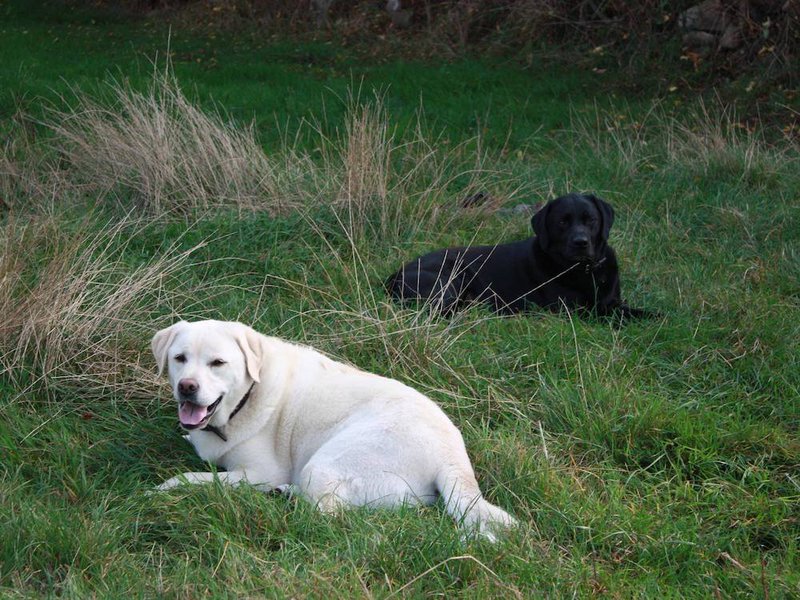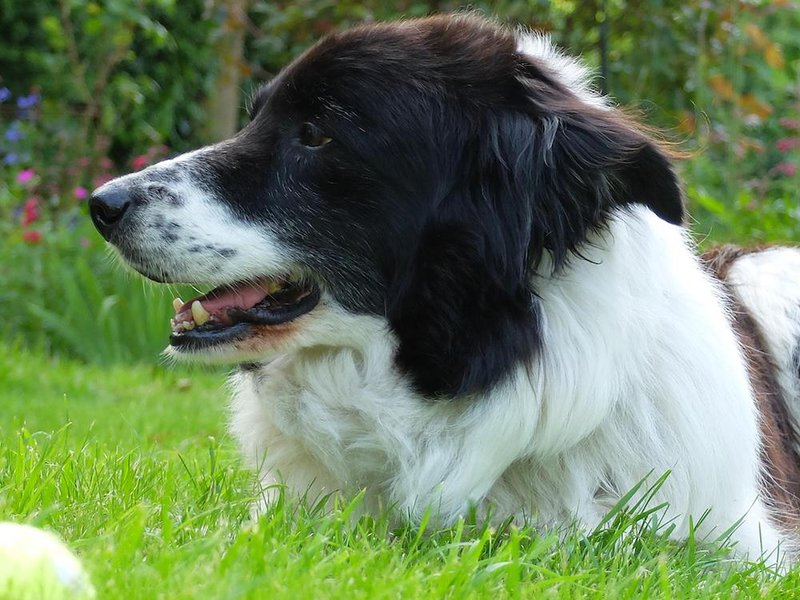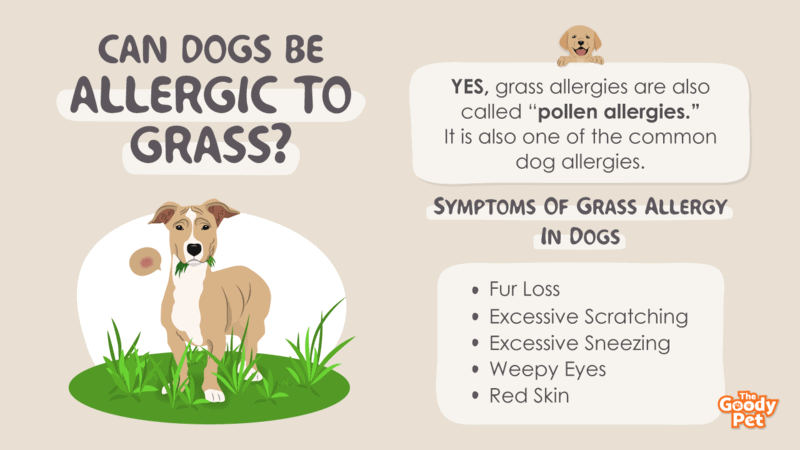It is entertaining to watch your four-legged furry friend playfully chase a Frisbee across the tall grass. During outdoor activities, dogs enjoy exercise and fresh air, joyfully wagging their tails as they play. No matter how enjoyable these activities are at first, for some dogs, this short time outside triggers a grass allergy. So, can dogs be allergic to grass?
Yes, some dogs may develop a grass allergy in which their skin and mucous membranes absorb grass pollens. Dogs with grass allergies may develop intense hives, facial puffiness (particularly around the eyes and muzzle), wheezing, breathing difficulties, or a faster breathing rate. Additionally, your canine friend may experience bloody or non-bloody diarrhea and vomiting.
To ensure your doggie does not get parasites from eating grass, have your dog’s parasite count checked regularly. Also, ensure your dog doesn’t chew grass, especially if it’s been treated with chemicals or pesticides. These can be harmful, or even dangerous, to doggies.
This article reviews common grass allergy symptoms you should watch for in your dog. We’ll also provide some helpful treatments to soothe your dog’s symptoms. But first, let’s examine what exactly a grass allergy is and its common causes.
Can Dogs Be Allergic To Grass?

Yes, dogs can be allergic to grass. Dog allergies happen more frequently than you might imagine. Just as some humans develop allergies, so do some dogs. Grass frequently affects dogs because of airborne pollen, and grass allergies are one of the more common dog allergies. Grass allergies are also called “pollen allergies.”
The dog’s skin absorbs the pollen, which can potentially trigger an allergic reaction. The majority of pollen transmission occurs there is direct contact with the grass. However, allergic reactions can also happen when pollen makes its way inside the house.
Meaning Of Grass Allergies In Dogs
Dogs frequently suffer from grass allergies, which are respiratory allergies that may be caused by grass pollen. Since grass pollen is airborne, your dog doesn’t even have to have contact with grass to develop allergy symptoms.
In a study held at the University of Veterinary Medicine Vienna, 262 trialed dogs failed a drug test for allergies to grass, weed, and tree pollen in more than 80% of the cases. Although not all dogs experience grass allergies, those who do may develop skin allergies or upper respiratory allergies as a result.
As grass allergies can affect your dog year-round, they are found to be typically worse in the spring and fall. During those seasons, grass pollen is more common. Dogs’ skin and mucous membranes absorb allergens (grass pollen). Many dogs who are allergic to grass could also be allergic to fleas or certain foods.
Age Of Dogs When Grass Allergies Develop
Dogs may develop a grass allergy at any age, but due to early allergen exposure, many dogs develop such allergies after they are one year old. Although your dog likely finds allergy symptoms annoying, most allergies aren’t life-threatening.
Severe allergic reactions, such as anaphylaxis, are possible, though uncommon. Anaphylaxis may occur within 5 to 30 minutes after contact with the allergen.
Anaphylaxis symptoms in dogs can include blue gums or tongue, labored breathing, hives, swelling, drooling, vomiting, or diarrhea. Contact a vet immediately or take your dog to an emergency clinic for help.
Causes Of Grass Allergies In Dogs
Common grass pollens that cause allergic reactions include alfalfa, Bermuda, fescue, or rye grasses. Such pollens are similar to those from cedar, pigweed, pine, oak, and ragweed.
Dogs who like to roll on the grass may develop symptoms from direct contact. Other dogs may develop symptoms from breathing in grass pollen during walks outside. Some dogs may contact grass pollen that has traveled indoors.
Allergies are more likely when grass grows and pollen travels on the wind in a yellow trail of dust, as seen in the fall and spring. Your four-legged furry friend may exhibit symptoms after entering a polluted region, and pollen contacts the mucous membranes on the nose, eyes, mouth, skin, and feet.
Is My Dog Allergic To Grass?
Grass is one of the most prevalent things that can cause a dog to develop an allergy. A dog’s allergy to grass is comparable to a person’s reaction to tree pollen. At a certain stage in a dog’s life, an allergic reaction to grass pollen may manifest itself.
Before you start the prevention and treatment of your dog’s allergy, it’s crucial to be certain of the reason. Examine every possibility, including items like food, medication, and other substances. A parasite like fleas could potentially be to blame for your dog’s symptoms.
A grass allergy is quite likely to be the cause of your canine’s red, itchy skin or feet, sneezing, and watery eyes, whether they play, walk, or just dwell near an area of grass. Simply call the vet to find out what is causing the disease if you observe this. Once there, you can also get expert advice on prevention and treatment.
Symptoms Of Grass Allergy In Dogs
Dogs’ allergic reactions differ slightly from humans’ allergic reactions. People may sneeze and cough more frequently, but dogs mostly scratch.
Dogs also may exhibit red irritated skin, fur loss, intense itching, and biting at the affected area. Since your dog may have hurt the affected spot, seek veterinary care as soon as possible. Additional dog allergy symptoms include runny eyes and excessive sneezing.
It is best to talk to a veterinarian. But if your dog has allergies, you’ll likely notice certain skin problems, which are more common than the respiratory problems that humans experience. Let’s review the common symptoms in more detail.
Fur Loss
Grass allergies and skin infections in dogs frequently cause partial or complete alopecia (fur loss). Any breed or age of dog might lose hair or fur. The underlying cause might range in severity from slight to major.
As grass allergies worsen or continue, the scratching and skin inflammation may result in hair-follicle trauma. Hair loss results. Even worse, some dogs may nip and bite their skin, also causing hair loss. Dogs frequently nip near the abdomen, legs, and tail.
So grass allergies and associated skin irritations may cause certain dogs to have less hair or fur. It is crucial that you notify a veterinarian right away if you observe fur or hair loss.
Excessive Scratching
Excessive scratching often results from grass allergies or other allergens like mold or pollen. Dogs who come in direct contact with certain irritants, like soaps or insecticides, may develop dermatitis, a skin rash.
If you observe your dog scratching and itching, this may be a sign of a grass allergy. Constant exposure to the grass or being outside may cause continued symptoms. One typical initial allergy sign in dogs is itchiness.
Excessive Sneezing

If your dog sneezes frequently, your furry friend may have an allergy. Another symptom of pollen allergies is reverse sneezing when a dog inhales air rapidly.
Weepy Eyes
Canine grass allergies may manifest as a watery eye or discharge. This symptom may accompany eye redness or puffiness, though watery eyes may also be the only symptom. This discharge may occasionally become mucoid (pus-like) and appear green or yellow.
Weepy eyes are a very typical issue in dogs. Reasons for this might range from somewhat commonplace conditions, like getting wind or grit in their eyes, to more significant medical conditions like glaucoma. If you see your dog has weepy eyes, talk to a veterinarian.
Red Skin
Dogs with grass allergies or other environmental allergies may develop redness, swelling, or itchiness on the skin around the lips, chin, paws, neck, or belly. If you notice these problems, consult a vet about how to treat your dog’s skin. Skin issues can cause a lot of pain, so it’s better to seek help sooner rather than later.
How Can I Treat A Dog That Is Allergic To Grass?
Fortunately, there are many ways to treat your dog’s grass allergy. Removing the pollen from your dog’s fur as early as possible is the best strategy. Use a moist cloth to clean the dog’s paws and body after a walk or outing at the park.
To stop the symptoms, it is critical to identify, or at least narrow down, the grasses your dog is allergic to. Dogs contact a variety of grasses, including those in fields, dog parks, and yards. Knowing which grasses are present in your neighborhood may help you avoid them and check symptom flare-ups.
Symptom management is the main treatment focus. Symptom severity determines the treatment course. If your dog’s allergy symptoms are mild, a vet may suggest the following topical treatments:
Oatmeal-Based Pet Shampoo
Regular bathing with an oatmeal-based pet shampoo helps remove allergens before they have a chance to be absorbed into the skin. Bathing could lessen or stop the irritation. Oatmeal shampoos come in a variety of brands and are sold over the counter.
Many dogs have delicate skin that can be irritated by a variety of factors, including cold temperatures, insect bites, dermatitis, fleas, and grass allergies. These sensitivities can result in itchy, irritated skin. Consistent oatmeal shampoo baths may help your dog and reduce its allergy symptoms. This means your dog will be more comfortable.
Antihistamine
When a dog has mild-to-moderate allergies, Benadryl is a fantastic antihistamine to try. Benadryl typically works for allergies to grass, foods, the environment, and even reactions to snake and insect stings.
Dogs that have skin allergies are frequently treated with Benadryl, which also lessens many other allergy symptoms. Drowsiness, a side effect of Benadryl, helps calm agitated dogs.
According to the Merck Veterinary Manual, diphenhydramine may help doggies experiencing mild-to-moderate travel-related anxiety symptoms. It might also lessen motion sickness.

Hydrocortisone Shampoo
Normally sold over-the-counter, hydrocortisone shampoo may help ease pain from red itchy skin. Never apply creams or ointments made for humans. Thicker creams may irritate the area and encourage your furry friend to lick more, aggravating the itching. Human shampoo products are not intended for pets.
Hydrocortisone shampoo is a lathering alcohol-free product. The anti-inflammatory hydrocortisone quickly soothes minor skin irritations and stops itching, which can aggravate your dog’s problem.
Short Doses Of Corticosteroids
The ability to reduce inflammation makes corticosteroids a useful class of drugs. Corticosteroids treat mild inflammatory diseases and suppress allergy-related inflammations.
Prednisone, prednisolone, dexamethasone, triamcinolone, and methylprednisolone are a few examples of frequently prescribed synthetic corticosteroids. This group of medicines has helped both people and animals for many years.
Drugs, such as prednisone, Apoquel (an oral tablet taken every day), or Cytopoint (an injection injected every 4 to 8 weeks), can help control itching. Since these are prescription drugs, talk to a vet about a prescription for your dog.
See Your Vet
You should not be alarmed if your dog exhibits signs of grass allergies since they are extremely common, especially in the spring. To relieve your dog’s discomfort and prevent symptoms from worsening, proper diagnosis and prompt treatment are essential.
Your veterinarian can assist in determining the origin of your dog’s symptoms or recommend a pet dermatologist to treat the grass allergies. Additionally, veterinarians can desensitize pets to environmental allergies like grass or pollen.
Treatments can ease your dog’s symptoms and stop allergies from developing into more serious problems. It is always important to ensure that your dog receives an accurate diagnosis and the best treatment for its conditions and long-term health.





